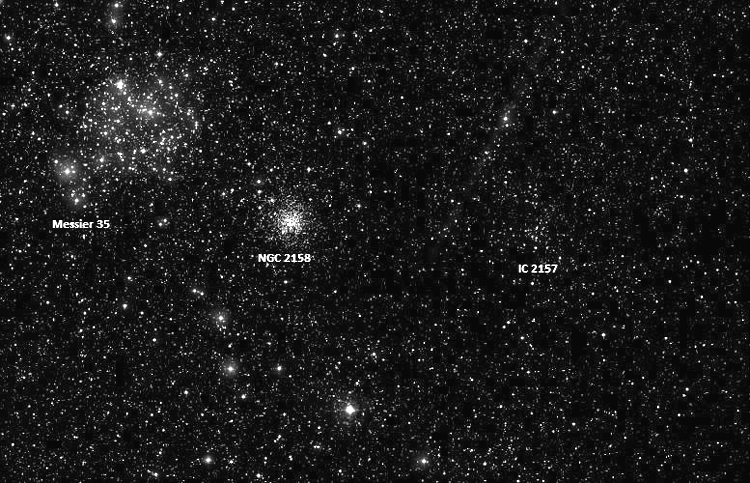As mentioned in my last article, the winter sky is a collection of thirteen bright stars seen in one large area. Add to this, an array of visual, binocular and telescopic targets and you have a fulfilling night to look up and enjoy.
Continuing our tour we come across the two bright stars representing the Gemini Twins. According to mythology, both Castor and Pollux are brothers with Castor being mortal and Pollux the son of the god Zeus in immortal. Castor is a white coloured star located 51 light years away and 1.5 times hotter than our Sun. In a telescope, Castor splits into two close components but the entire Castor system consists of three pair of stars or a system of six suns.
Pollux is more of an orange colour star meaning it is burning cooler than his brother. This 34 light year sun is home to a planet measuring about 30 earth diameters wide and orbits its parent star in 1.6 earth years. The planet is exposed to 16 times the radiation we receive from our Sun. But still, another visible star with a sibling planet.
Down towards the foot of Castor is a fantastic open cluster of stars that is a favourite at public star parties. Catalogued as M35, it can be spotted with the unaided eye on a moonless night, far from stray lights. Residing 2,800 light years away M35 appears the same size as the full moon, contains more than 500 stars. You will need binoculars to see a much smaller and fainter star cluster referred as IC 2158 to the west. With IC 2158 three times farther away both show nicely in low power binoculars.
Moving south and to the east is the bright star Procyon of the constellation Canis Minor. At only 11.4 light years away, Procyon measures twice the size of our Sun and is the eighth brightest star in the entire sky. Procyon also has a dwarf companion star that is far too difficult to be seen optically. They circle each other in a little more than 40 years. Procyon along with the star Betelgeuse and Sirius form the winter triangle just as have seen in summer.
Speaking of Sirius, it is the brightest sun in the constellation Canis Major as well as brightest viewed from Canada. Residing a mere 8.6 light years, it is the second of Orion’s two hunting dogs. Sirius, referred as the “dog star” plays a part in the term “dog days of summer”. Early civilizations knew this brilliant star appeared in the same area of sky as does the Sun in July and concluded this probably added to the summer’s heat for about a three week period. Of course this in not true. There is however a lovely but faint open star cluster located below Sirius catalogued as M41. This group of about 100 stars are located 2,300 light years away. Binoculars are required to see it.
In our yearly orbit around the Sun, the tilt of the Earth allows us to experience the four seasons. Coming up to the spring equinox on March 20, there is a phenomenon seen in the western sky. For a two week period commencing February 13 when the moon is absent, look for the zodiacal light – Sun light reflecting off lingering interplanetary dust from the creation of the solar system. Taking advantage of dark sky conditions of Northeastern Ontario, this faint beam of greyish light can be seen projecting from the horizon to the upper left and ending below the Pleiades star cluster.
Planets always dominate the night sky. Venus is still extremely brilliant in the western sky. Using orangey coloured Mars to the upper left follow Venus over the course of the next few weeks as it slowly increases its separation and sinks lower into the west. Venus is now positioning itself between the Sun and Earth. Use a telescope to see the lovely phase structure the planet is going through. Over the weeks, the crescent grows larger with but thinner until it is too close to the Sun to be seen safely. This is my favourite time to see and image Venus. Both planets disappear by 8:30 p.m. local time.
The planet Jupiter which is not as bright as Venus but still unmistakable, is well above the eastern horizon by 10:30 p.m. local time. Referred as the “King” of the planets, Jupiter lies beyond the Earth and will not demonstrate crescents like Venus but does have its own uniqueness to it. Peering through a telescope we first see the Galilean moons, named in honour of Galileo. As they circle Jupiter in independent orbits, you might see all four on either side of the planet. There are times when these moons transit across the Jovian face and cast a shadow(s) onto the planet’s striped coloured cloud tops below.
Until next time, clear skies everyone.
Gary Boyle is past President of the Ottawa Centre of the Royal Astronomical Society of Canada and has been interviewed numerous times on Canadian radio stations. Gary is an astronomy educator and lecturer with a never ending passion for the night sky.
Look for the International Space Station passing near or over:
Chapleau – Cochrane – Elliot Lake – French River – Iroquois Falls
Kapuskasing – Killarney – Kirkland Lake – Manitoulin Island – Mattawa – Moosonee
North Bay – Sudbury – Temagami – Temiskaming Shores – Timmins – Wolf Lake









